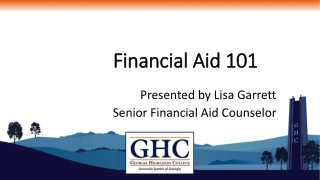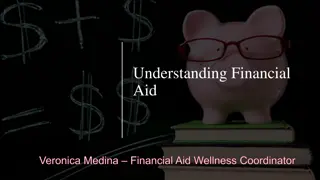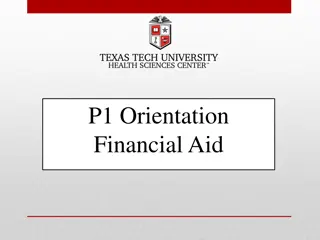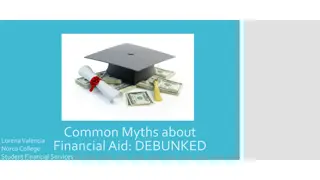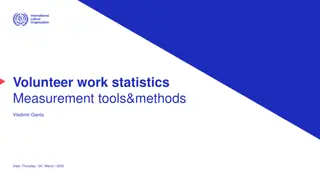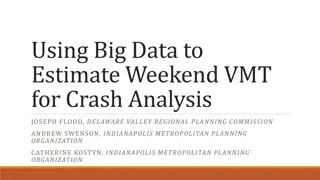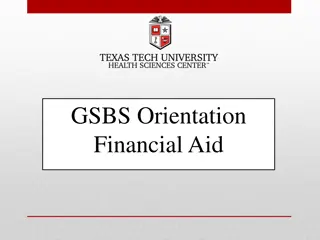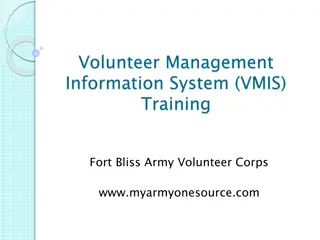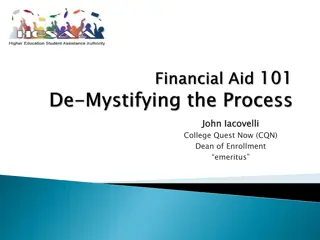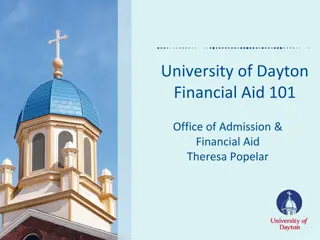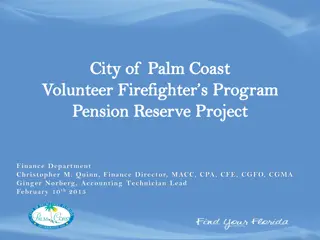
Grinnell College Enrollment and Financial Aid Insights
Discover key insights on enrollment, financial aid, and market position at Grinnell College, including student demographics, grant distribution, average debt upon graduation, and trends over the years.
Download Presentation

Please find below an Image/Link to download the presentation.
The content on the website is provided AS IS for your information and personal use only. It may not be sold, licensed, or shared on other websites without obtaining consent from the author. If you encounter any issues during the download, it is possible that the publisher has removed the file from their server.
You are allowed to download the files provided on this website for personal or commercial use, subject to the condition that they are used lawfully. All files are the property of their respective owners.
The content on the website is provided AS IS for your information and personal use only. It may not be sold, licensed, or shared on other websites without obtaining consent from the author.
E N D
Presentation Transcript
2017 Profile, Aid, and Market Position Joe Bagnoli Vice President for Enrollment Dean of Admission and Financial Aid 1
2 2017 Class Profile and History
3 One-Year Highlights On target (450 new and transfer students) Highest underrepresented students of color in four years Fewer than 30% of international students from China Highest test score average Highest net revenue per student
4 Five-Year Highlights Maintained racial diversity Improved academic profile 27% in net tuition revenue per student
5 Share of Students with Grants Percent with Grant Aid, 2017 Grinnell College St Olaf College Smith College Pomona College Washington and Lee University Vassar College Amherst College Oberlin College Macalester College Davidson College Carleton College Colorado College Bowdoin College Swarthmore College Kenyon College Reed College Williams College 0 10 20 30 40 50 60 70 80 90 100
6 Size of Grants Average Grant/Student, 2017 Grinnell College Amherst College Vassar College Smith College Pomona College Macalester College St Olaf College Swarthmore College Davidson College Williams College Oberlin College Washington and Lee University Carleton College Colorado College Kenyon College Bowdoin College Reed College $- $5,000.00 $10,000.00 $15,000.00 $20,000.00 $25,000.00 $30,000.00 $35,000.00
7 Graduate Indebtedness AverageDebt Upon Graduation 2012 - 2016 $28,216 St Olaf $25,696 Oberlin $23,250 Washington & Lee $23,038 Macalester $22,980 Smith $22,793 Kenyon $21,380 Davidson $20,794 Bowdoin $20,728 Colorado $20,489 Swarthmore $19,455 Reed $19,259 Carleton $17,705 Amherst $17,477 Vassar $16,775 Grinnell $15,509 Pomona $13,988 Williams $0 $5,000 $10,000 $15,000 $20,000 $25,000 $30,000
8 Average Debt Trend Grinnell College Average Indebtedness Upon Graduation $25,000 $19,392 $20,000 $18,780 $16,570 $16,315 $15,982 $15,000 $10,000 $5,000 $- 2013 - 14 2014 - 15 2015 - 16 2016 - 17 2017 - 18
9 Type of Aid Awarded Grinnell College Total Aid by Type $60,000,000 $2,647,800 $2,839,237 $2,693,900 $2,487,774 $4,633,250 $4,327,500 $5,227,218 $2,285,504 $3,785,559 $3,763,519 $50,000,000 $40,000,000 $30,000,000 $51,049,540 $50,097,776 $49,627,955 $49,052,283 $47,002,710 $20,000,000 $10,000,000 $- 2013 - 14 2014 - 15 2015 - 16 2016 - 17 2017 - 18 Total Grant Total Loan Total Work
10 Grant Sources Grinnell College Grant Aid by Source $52,000,000 $1,674,942 $50,000,000 $1,673,765 $1,512,181 $1,711,285 $1,472,141 $48,000,000 $1,727,700 $227,941 $1,828,791 $1,821,526 $337,018 $1,301,220 $313,790 $46,000,000 $314,150 $1,961,929 $44,000,000 $331,549 $47,435,372 $46,359,293 $45,973,193 $45,444,466 $42,000,000 $43,408,012 $40,000,000 $38,000,000 2013 - 14 2014 - 15 2015 - 16 2016 - 17 2017 - 18 Institutional Grant State Grant Federal Grant Other Grant
11 Need-Based vs. Merit Based Grants $50,000,000 $45,000,000 $40,000,000 $35,000,000 $30,000,000 $41,182,883 $41,166,264 $40,445,844 $40,314,309 $39,098,634 $25,000,000 $20,000,000 $15,000,000 $10,000,000 $5,000,000 $6,252,489 $5,527,349 $5,193,029 $5,130,157 $4,309,378 $- 2013 - 14 2014 - 15 2015 - 16 2016 - 17 2017 - 18 Merit-Based Grant Need-Based Grant
Compared to our need-blind peers Grinnell s endowment spending is not replaced at the rate of our peers. They bring in millions more in gifts annually. Our need-blind peers generate much more in net tuition revenue. They have a far higher percentage of full-pay students. They can more easily afford a higher spending rate from their endowment.
Trinity Emory Wake Forest Boston Georgetown Middlebury Brown Columbia Dartmouth Holy Cross Claremont McKenna Northwestern Chicago Brandeis Bowdoin Cornell Johns Hopkin s Hamilton Swarthmore U. Penn. Duke Richmond Haverford Notre Dame Williams Davidson Cal Tech M.I.T. Vassar Stanford Rochester Yale Amherst Pomona Wellesley Princeton Smith Vanderbilt Rice Harvard Grinnell Source: National Center for Education Statistics, 2013
Generating More Student Revenue In a stable enrollment environment, this requires awarding less financial aid. We want to continue meeting 100% of need without increasing loan levels in financial aid packages. Either we can enroll students who need less financial aid or we can award less in merit-based financial aid to those without financial need. Our merit aid program is critical in yielding students with no financial need and helps us generate student revenue. By increasing market demand for Grinnell, we hope to reduce the level of investment we make in merit aid without substantially affecting the composition of students.
Perceptions of Grinnell To determine recruitment and promotional strategies, we study market perceptions among students throughout the admission process. Non-applicant Inquirers think Grinnell is a great college, but they often don t apply for admission. Regular Decision Admits most often choose us for the strength of our academic programs, followed by the quality of their campus visit and their financial aid package. Non-enrolling Admits are most often looking for a different location.
Non-Applicant Inquirers [*] Which schools do you associate most with each of the following attributes? (Select all that apply for each)
Non-Applicant Inquirers [*] And, what do you believe Grinnell College s biggest challenges are today? (Select all that apply)
18 Regular Decision Admits Why did you choose Grinnell even though it wasn't your top choice? Other The location of the school Contact with the admissions staff Contact with a coach or faculty member Scholarship/financial aid My campus visit experience Academics 0.0% 10.0% 20.0% 30.0% 40.0% 50.0% 60.0% 70.0% 80.0% 90.0% 2016 2017
19 Non-enrolling Admits Why non-enrolling didn't more seriously consider Grinnell? Costs too much Other Size was wrong Didn't have a strong reputation It was a safety school Didn't know much about it Not the location I was seeking 0.0% 10.0% 20.0% 30.0% 40.0% 50.0% 60.0% 70.0% 80.0% 90.0% 2016 2017
20 Market position and demand Why will students choose Grinnell when they can get a great education in a location they much prefer? Grinnell has fewer majors available than our peers and few popular, non-redundant majors. How can we make traditional majors and new programs look more enticing than they appear at respectable colleges in more desirable locations? The market position challenge is significant and the stakes are high (we re depending upon substantial increases in net student revenue to fund financial aid long-term). Our pitch has to work really hard to answer the $63,114 question. We must present a relevant, distinguishing, compelling version of Grinnell to lift eyes over corn tassels.




